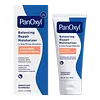What's inside
What's inside
 Key Ingredients
Key Ingredients

 Benefits
Benefits

 Concerns
Concerns

 Ingredients Side-by-side
Ingredients Side-by-side

Water
Skin ConditioningGlycerin
HumectantNiacinamide
SmoothingHydroxyethyl Acrylate/Sodium Acryloyldimethyl Taurate Copolymer
Emulsion StabilisingLinoleic Acid
CleansingPhospholipids
Skin ConditioningSphingolipids
EmollientTocopherol
AntioxidantSodium Hyaluronate
HumectantCentella Asiatica Extract
CleansingAllantoin
Skin ConditioningPhenylpropanol
MaskingHydroxyacetophenone
AntioxidantPropanediol
SolventCaprylyl Glycol
EmollientOleic Acid
EmollientPalmitic Acid
EmollientPolysorbate 60
EmulsifyingSorbitan Isostearate
EmulsifyingStearic Acid
CleansingTetrasodium Glutamate Diacetate
1,2-Hexanediol
Skin ConditioningLinolenic Acid
CleansingPolylysine
Pentylene Glycol
Skin ConditioningWater, Glycerin, Niacinamide, Hydroxyethyl Acrylate/Sodium Acryloyldimethyl Taurate Copolymer, Linoleic Acid, Phospholipids, Sphingolipids, Tocopherol, Sodium Hyaluronate, Centella Asiatica Extract, Allantoin, Phenylpropanol, Hydroxyacetophenone, Propanediol, Caprylyl Glycol, Oleic Acid, Palmitic Acid, Polysorbate 60, Sorbitan Isostearate, Stearic Acid, Tetrasodium Glutamate Diacetate, 1,2-Hexanediol, Linolenic Acid, Polylysine, Pentylene Glycol
 Reviews
Reviews

Ingredients Explained
These ingredients are found in both products.
Ingredients higher up in an ingredient list are typically present in a larger amount.
Water. It's the most common cosmetic ingredient of all. You'll usually see it at the top of ingredient lists, meaning that it makes up the largest part of the product.
So why is it so popular? Water most often acts as a solvent - this means that it helps dissolve other ingredients into the formulation.
You'll also recognize water as that liquid we all need to stay alive. If you see this, drink a glass of water. Stay hydrated!
Learn more about Water